Post-layoffs, tech talent boosts non‑tech companies
Underneath the layers of layoff news and data around hiring cutbacks in Big Tech, there’s another story: the continued supply of early tech talent and desire from college grads to pursue careers in tech.
In the past, Big Tech had first dibs. Today, there’s a new opportunity for non-tech name brands and small employers alike to take advantage of the continued availability of skilled tech talent among college grads.
Good news, because in 2023, every company is a tech company. Every industry is undergoing digital transformation that requires talent with skills to help them keep up.
Our latest data findings demonstrate the abundance, flexibility, and eagerness of early tech talent supply—grads with tech skills and tech majors are applying outside of Big Tech to start their career—and the opportunity for companies that take advantage of this crucial moment in the job market to succeed.
Key takeaways
- Tech majors are looking to new industries as they apply to full-time jobs—including government and healthcare.
- Students are applying beyond the traditional coastal tech hubs in 2023 compared to previous years for both full-time and internship roles.
- Tech majors on Handshake are more active than their peers, applying to 2x more jobs than others on Handshake, and more than 50% apply to 10+ full-time roles.
Demand for tech skills outpaces employment
Tech-related roles are expected to grow at 2x the rate of overall employment in the US, with many tech occupations growing at 4x-5x the national rate (US Department of Labor).
Why? A recent McKinsey report highlighted that the most productive firms in every sector widened their lead against competitors over the last 30 years by investing in tech and tech talent.
Leading firms
invest 2.6x
more in technology, research and intellectual property, and attract and invest in more skilled talent.
As a result, industry trends are predicting:
$162B
in unrealized revenue
Across the tech, media, and telecom industries by 2030 as a result of skilled talent shortages
Korn Ferry87%
of orgs unprepared to face skills gap
As indicated by global senior executives surveyed by McKinsey
McKinsey3.5M
STEM jobs in manufacturing
Forecasted for just the manufacturing industry by 2025
NAM and DeloitteWidening this gap is the aging workforce. According to the US Census Bureau, by 2030, all baby boomers will be older than 65. The share of the population that is retirement age will increase to 21%. At the same time, an estimated 42% of the skills and expertise required to capably perform in a given position will be known only by the person currently in that position.
Taken together, these conditions show that companies are facing an almost certain knowledge deficit within the workforce, equating to lower productivity, efficiency, and revenue loss.
Subscribe to stay on top of early talent recruiting trends
Success!
Demand, meet supply. Tech talent is eyeing new industries in 2023.
Tech majors are looking to new industries as they apply to full-time jobs. They’re seeing the headlines reporting Big Tech layoffs and are applying to a wider range of industries than the class of 2022. In a survey to the class of 2023 this winter, 40% said they are open to apply to more industries as a result of news about the economy.
These findings are echoed in our product data. While applications from tech majors to the tech industry have dropped by 4.0 percentage points and applications to finance and professional services have dropped by 0.9 percentage points, there has been an increase of 1.4 percentage points in applications to government and an increase of 0.6 percentage points in applications to non-profits.
Clearly all other industries besides tech are seeing an increase in applications and tech student interest—even earlier in the college journey. For students with tech majors applying to internships this year, we also see a drop in applications to tech of 8.1 percentage points and an increase in applications for all other industries.
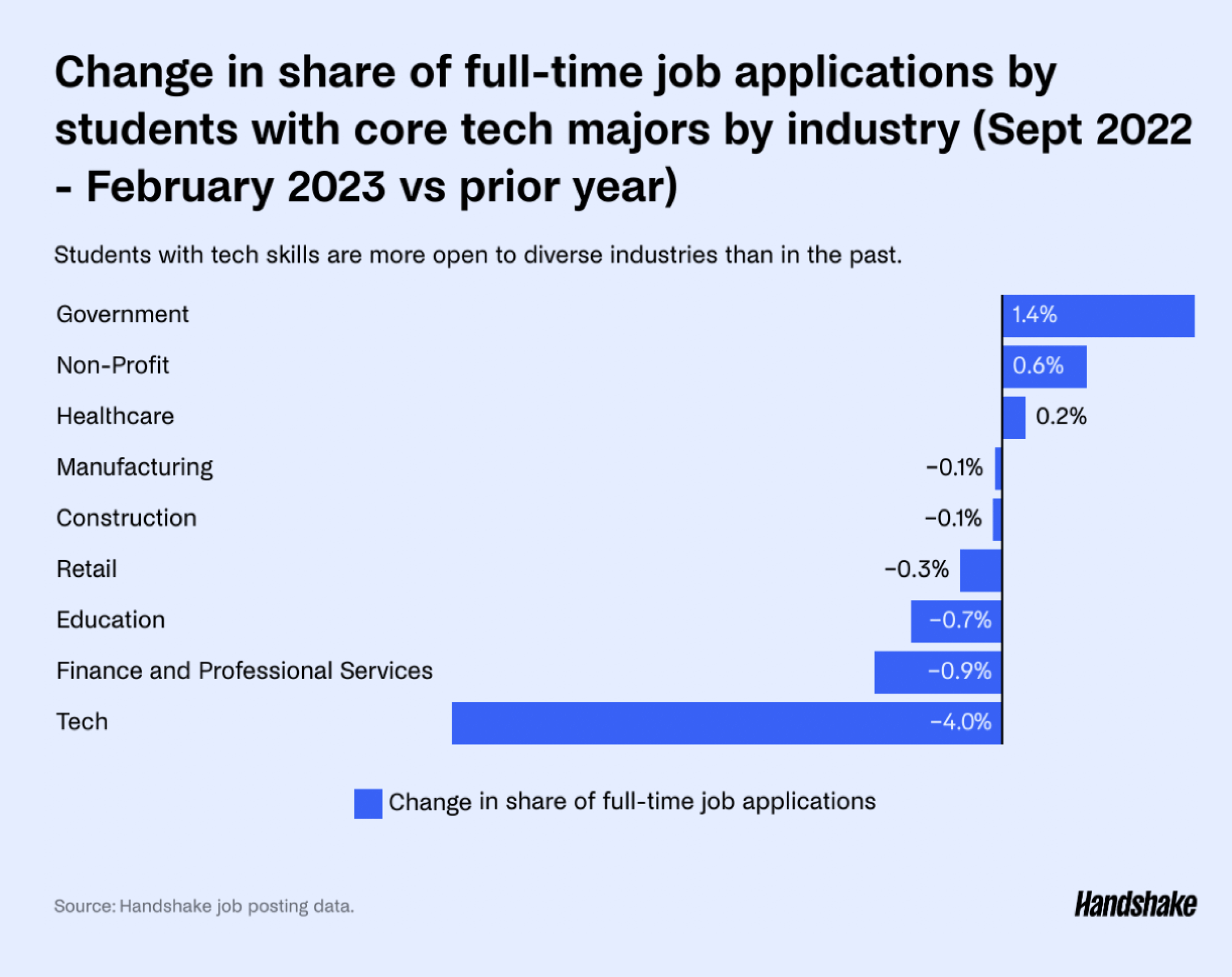
The rise in fields like healthcare, government, and nonprofits signal a shift and opportunity, for both employers and students. Competitive candidates with tech skills are forging new career paths outside of the tech industry, bringing their skills to fields that might be well-suited to meet their interests, values, and drive for impact.
Talent is also on the move, and applications outside of major tech hubs are on the rise.
Students are applying to more diverse locations in 2023 compared to early years for both full-time and internship roles. In fact, 68% of respondents in the class of 2023 said they are open to relocate based on market conditions.
In the past, most tech talent was pulled toward California, Massachusetts, New York, Texas, and Washington where Big Tech firms are based and VC funding is the highest. Today, the majority of tech majors are applying outside of the most common states for tech.
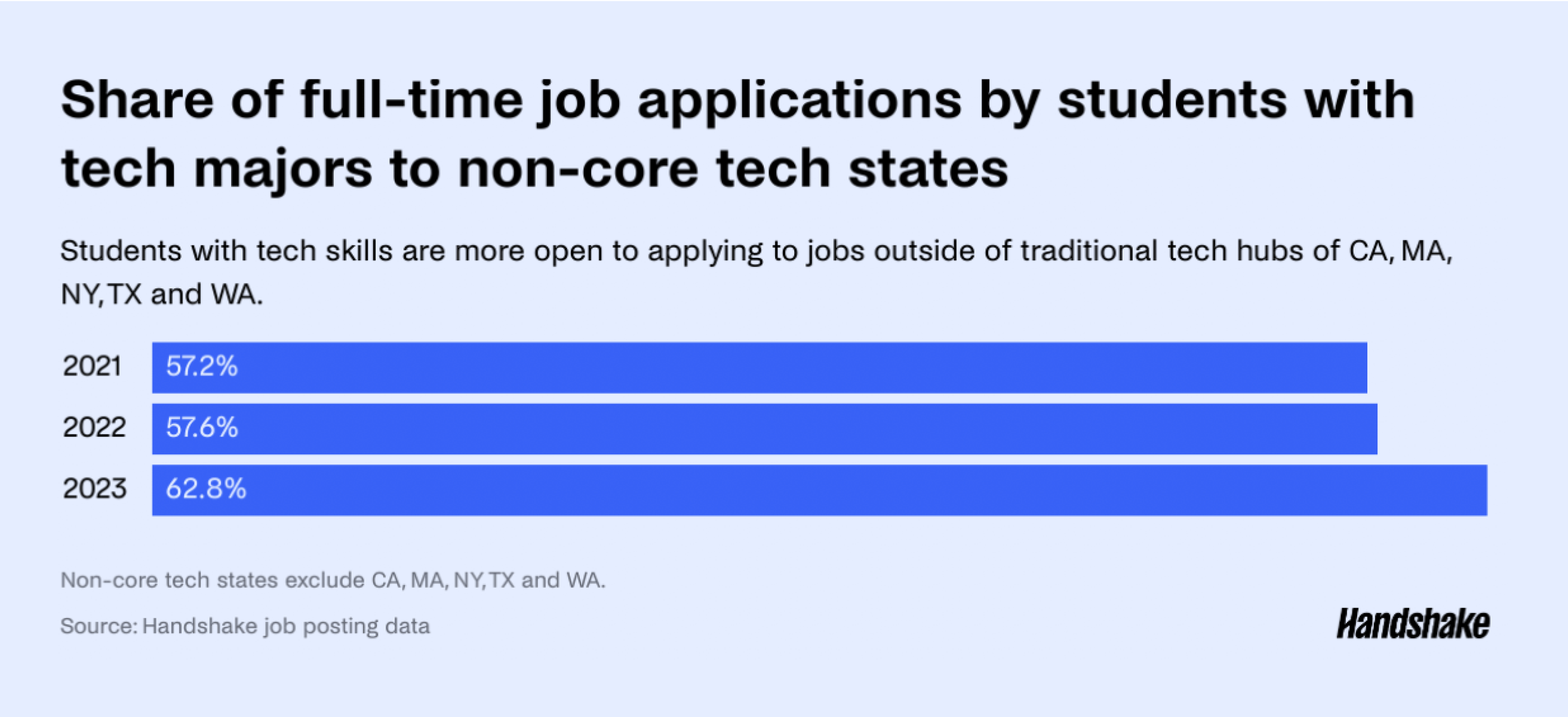
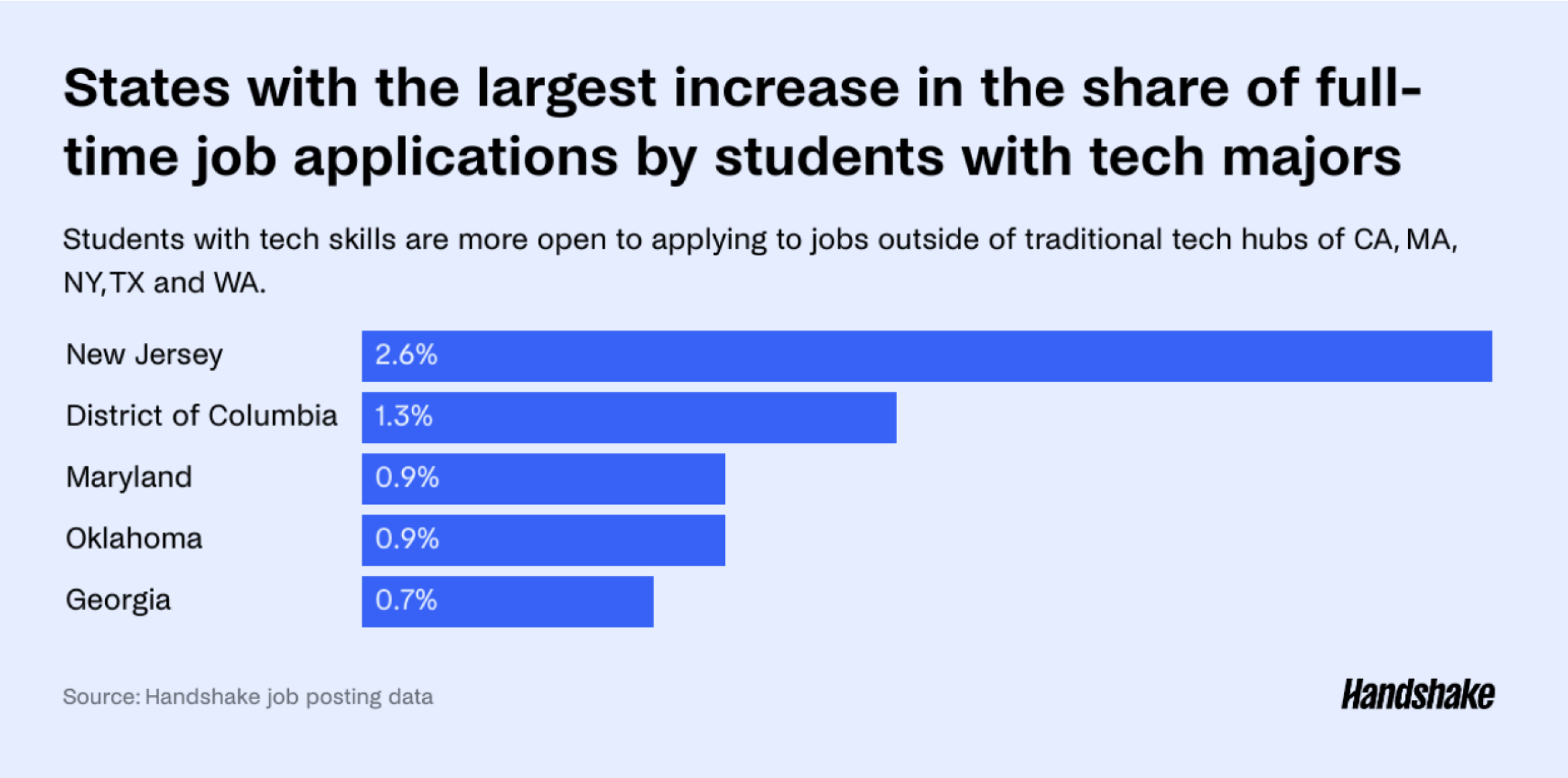
Remote work possibilities mixed with the economic downturn have opened the door for talent to explore new industries in new locations, signaling to employers that there is a window of opportunity to attract on-the-move talent now.
What roles are capturing Gen Z tech talent’s attention?
Tech majors on Handshake are more active than their peers, applying to 2x more jobs than other talent on Handshake, and more than 50% apply to 10+ full-time roles.

Non-tech industries should pay special attention to the opportunity that tech-skilled students (not necessarily majors) bring to the table.
Handshake data showed that the second most popular jobs for tech majors and for students with tech skills (such as programming and computer languages) are business analysts and management consulting. The popularity of these roles among students with programming skills signals the widespread need for tech talent beyond traditional tech employers.
Just as all companies are transforming into tech companies, all business problems increasingly require tech solutions to surface insights and make informed solutions. All industries can tap into this cohort for roles to help bridge the gap between existing processes and new tech adoption.
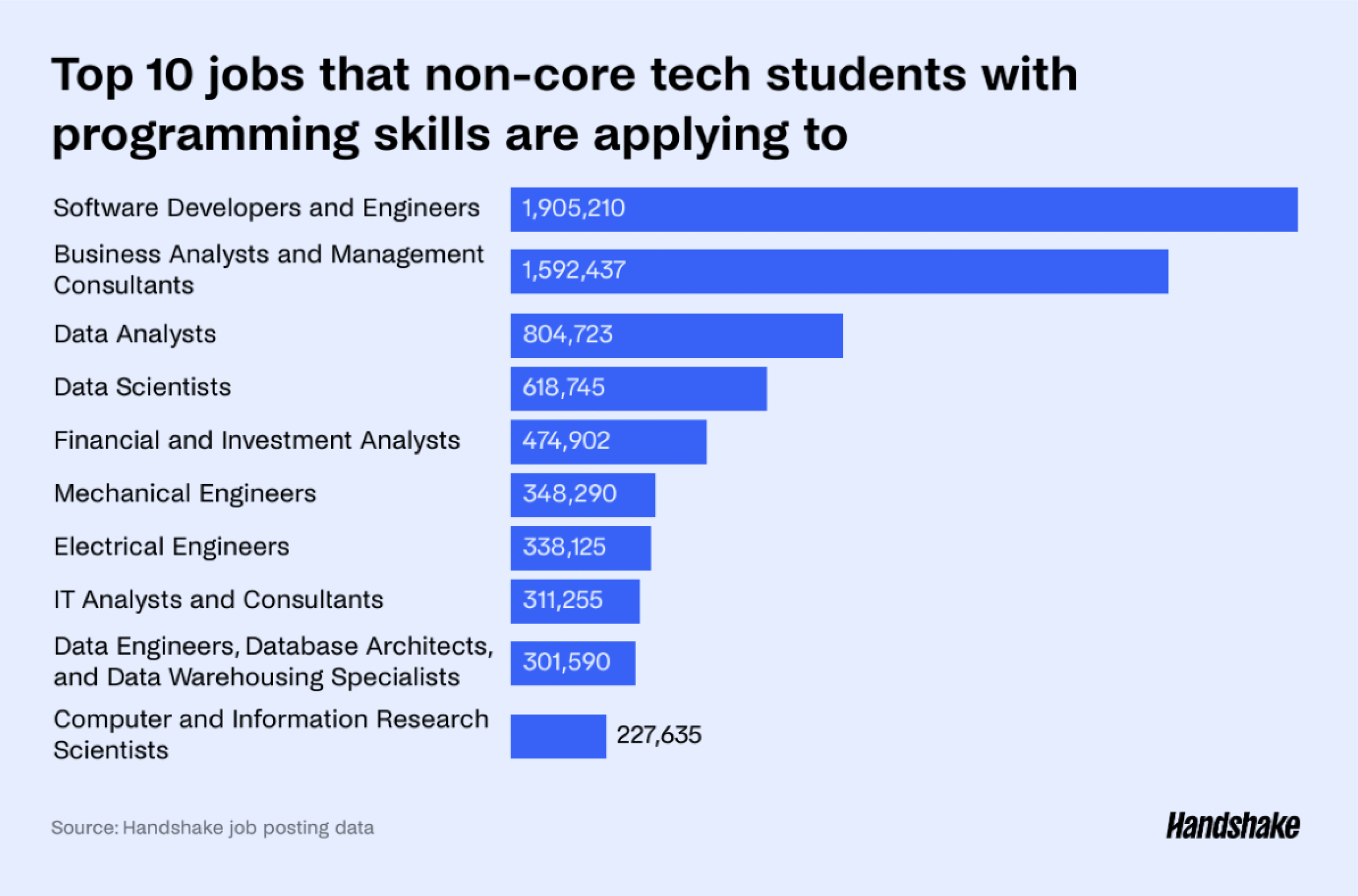
Hiring is tight, budgets are cut, how can organizations capture this moment?
Skilled early career tech talent can save companies millions:
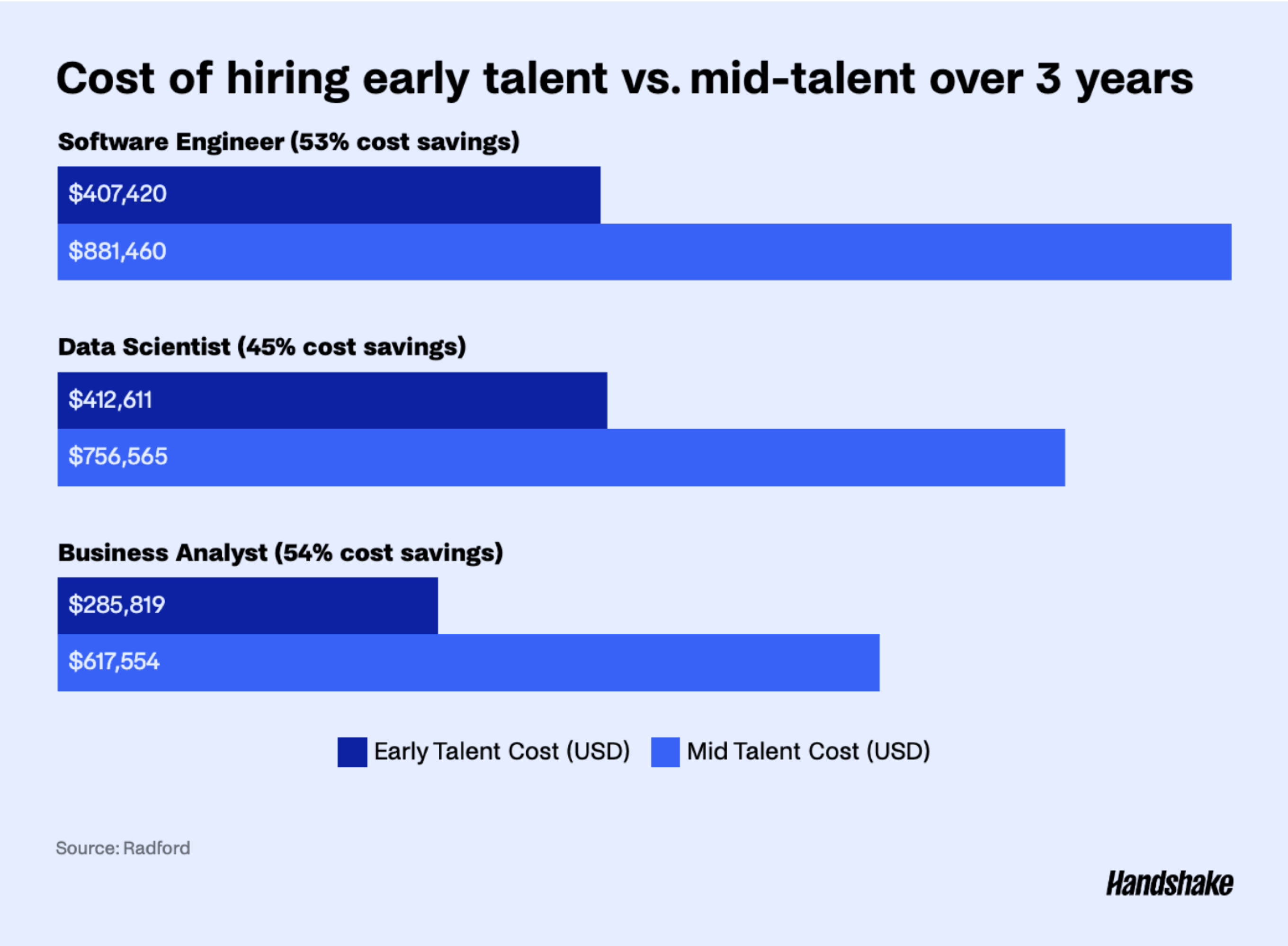
Tech talent is on the move, and now is the moment to attract these competitive workers. For organizations that can only make investments for tomorrow that still deliver measurable benefits today, early tech talent is the solution.
Methodology
When looking at applications to Handshake job postings, applications are limited to within 30 days of the job being posted. Additionally, students defined as tech majors or core tech include those with major groups of Information Systems Management, Computer Science, Computer Programming, Computer Engineering, Computer Engineering Technologies & Technicians, Business Analytics, Data Science, Data Mining, Mathematics, Statistics, Software Design, User Experience/ Social Computing, Cyber Security, and Computer Systems Networking & Telecommunications.
Compensation data (inclusive of median salary, equity and target bonuses) was derived from 2022 Radford data. Hiring cost as a percentage and annual raises over time were derived from Zippia and Robert Half studies respectively. These statistics were extrapolated over 3 years to show the long-term cost savings of hiring early talent.